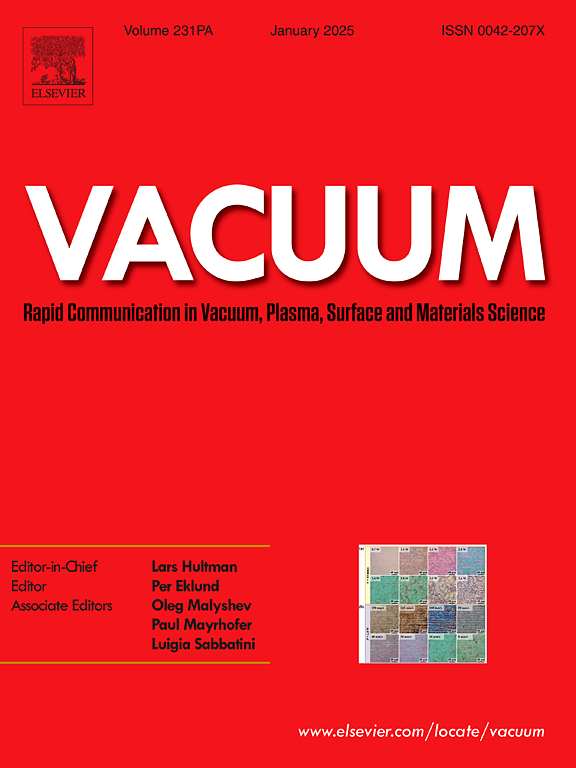Fabrication of 4-inch single-crystalline InP thin film on Si substrate by ion-cutting technique with wafer bonding at elevated temperature
IF 3.9
2区 材料科学
Q2 MATERIALS SCIENCE, MULTIDISCIPLINARY
引用次数: 0
Abstract
The integration of InP thin films onto silicon substrates holds significant promise for optoelectronic device applications. However, achieving large-area, high-quality single-crystal InP films on silicon remains a major challenge. In this work, 4-inch, 200 nm-thick single-crystal InP thin films were successfully transferred onto silicon substrates using ion-cutting of an InP/InGaAs epitaxial structure. To address thermal stress issues during the ion-cutting process for large-area heterogeneous integration wafers, finite element simulations were conducted to analyze thermal stress distributions under different bonding and annealing temperatures. The simulation results revealed abrupt thermal stress concentrations at the edges of the InP/Si bonding pairs, which could be mitigated by bonding at an elevated temperature of 55 °C. The InP/InGaAs epitaxial structure effectively reduced the residual H-ion concentration of the InP film after annealing, with defects localized in the epitaxial InGaAs layer. Following the selective etching of the InGaAs layer, a high-quality 4-inch InP thin film was obtained, exhibiting a surface roughness of 0.347 nm, a full width at half maximum (FWHM) of 212.4 arcsec for the X-ray rocking curve, and a thickness uniformity of 98 %. The large-area InP/Si heterogeneous integration substrate fabricated by ion-cutting with wafer bonding at elevated temperature represents a promising material platform for optoelectronic integration and high-speed electronic applications.
采用离子切割技术在Si衬底上制备4英寸单晶InP薄膜
将InP薄膜集成到硅衬底上对光电器件应用具有重要的前景。然而,在硅上实现大面积、高质量的单晶InP薄膜仍然是一个主要的挑战。在这项工作中,通过离子切割InP/InGaAs外延结构,成功地将4英寸,200纳米厚的单晶InP薄膜转移到硅衬底上。为了解决大面积非均质集成硅片离子切割过程中的热应力问题,采用有限元模拟方法分析了不同键合温度和退火温度下的热应力分布。模拟结果显示,在InP/Si键合对的边缘出现了突然的热应力集中,在55℃的高温下键合可以减轻这种集中。InP/InGaAs外延结构有效地降低了退火后InP薄膜的残余h离子浓度,缺陷集中在外延InGaAs层上。通过对InGaAs层的选择性刻蚀,获得了高质量的4英寸InP薄膜,其表面粗糙度为0.347 nm, x射线摇摆曲线的半最大全宽度(FWHM)为212.4 arcsec,厚度均匀性为98%。高温离子切割结合晶圆键合技术制备的大面积InP/Si非均质集成衬底为光电集成和高速电子应用提供了广阔的材料平台。
本文章由计算机程序翻译,如有差异,请以英文原文为准。
求助全文
约1分钟内获得全文
求助全文
来源期刊

Vacuum
工程技术-材料科学:综合
CiteScore
6.80
自引率
17.50%
发文量
0
审稿时长
34 days
期刊介绍:
Vacuum is an international rapid publications journal with a focus on short communication. All papers are peer-reviewed, with the review process for short communication geared towards very fast turnaround times. The journal also published full research papers, thematic issues and selected papers from leading conferences.
A report in Vacuum should represent a major advance in an area that involves a controlled environment at pressures of one atmosphere or below.
The scope of the journal includes:
1. Vacuum; original developments in vacuum pumping and instrumentation, vacuum measurement, vacuum gas dynamics, gas-surface interactions, surface treatment for UHV applications and low outgassing, vacuum melting, sintering, and vacuum metrology. Technology and solutions for large-scale facilities (e.g., particle accelerators and fusion devices). New instrumentation ( e.g., detectors and electron microscopes).
2. Plasma science; advances in PVD, CVD, plasma-assisted CVD, ion sources, deposition processes and analysis.
3. Surface science; surface engineering, surface chemistry, surface analysis, crystal growth, ion-surface interactions and etching, nanometer-scale processing, surface modification.
4. Materials science; novel functional or structural materials. Metals, ceramics, and polymers. Experiments, simulations, and modelling for understanding structure-property relationships. Thin films and coatings. Nanostructures and ion implantation.
 求助内容:
求助内容: 应助结果提醒方式:
应助结果提醒方式:


